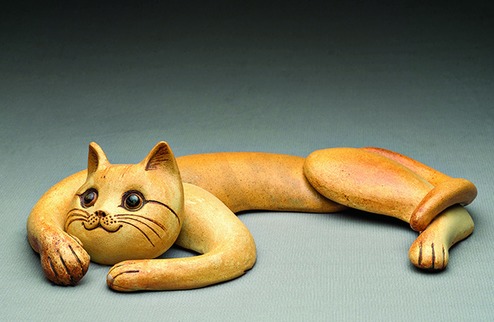
Along with the mutating volumes, forms and shapes that stand out because of their simplicity, the most striking aspect of Jyotsna Bhatt's ceramics, displayed at her recent exhibition at Galerie 88, is the tactile quality and beauty of the mattes in teal or burnt terracotta. They have the texture and feel of the finest tussar. The glazed pieces are not shiny, and although the shades are earthy, they have the muted glow and warmth of satin.
Bhatt is the better half of artist and photographer, Jyoti Bhatt, and both have lived and taught at M.S. University in Baroda for years. Jyotsna Bhatt is from Kutch and she shifted to Mumbai to join the J.J. School of Arts. That was in the late 1950s, but after a few months in Mumbai, she shifted to M.S. University in Baroda.
She concluded her training in sculpture under Sankho Chaudhuri. Although she had opted for sculpture, in the first year all students have to get basic training in all subjects. Pottery was her secondary subject, but she fell in love with it. "All methods and technical possibilities interest me, and I like to experiment with all technical possibilities - wheel, slab, coil. I have tried all the methods," says Bhatt, who was here at the opening. After Baroda, she continued her training at the Brooklyn Museum Art School.

At the very beginning, she learnt making basic forms. The veteran ceramic artist admits she has never created very large pieces, and even though her works vary in size, the larger ones are assemblages of smaller pieces done separately and later fitted together. The cats - and there were several pieces of these "toys" - are fine examples of such assembled pieces. Her works come in many forms. The most beautiful ones are the "lotus buds" with flame-like petals conjoined at the tip like hands folded in prayer (picture, bottom), the serene, spherical bowl-like shapes, platters that resemble striated cross-sections of tree trunks, pipes with flowers blooming along their rim, and hollow spherical bouquets that look like they were chiselled out of a single block of stone. The mischievous cats lie in various attitudes of lassitude (picture, top). The discs with what look like hands spread out at the centre or with perforations around them are multifarious in colour and texture. There is never a grand gesture. She does not hesitate to make small bowls, and she does not lose her sleep if she is charged with creating utilitarian objects.
Jyotsna Bhatt tends to be repetitive much too often, but it is in the making of the dishes with variegated designs that she lets herself go. The designs swerve between the bold and the subtle, and their colouring, likewise, is either bright or muted. She does plenty of sketches before starting to work.
The lotus buds are of indigenous origin, but the crowing roosters, tiny birds, fish and owls could be from anywhere in the world. They are more akin to painting than sculpture as they are in low relief. The texture is dependent on the selection of materials used, chemistry and firing in the kiln which she fine-tunes to achieve the effect she desires. The rich mottled effects with a glowing aura are achieved with the various minerals that Bhatt plays with.
She enjoys completely trapping volume in the balloon-like shapes. For the flowers she rolls out clay, uses a cookie cutter for shapes and does the modelling thereafter. She says the methods of firing are multifarious, and a kiln fired with wood can impart beautiful colours. And one can leave it at that. It is complete in itself.










